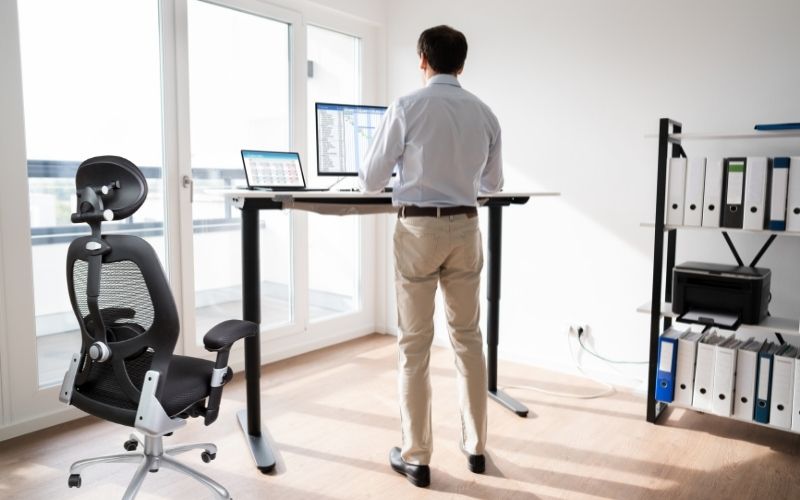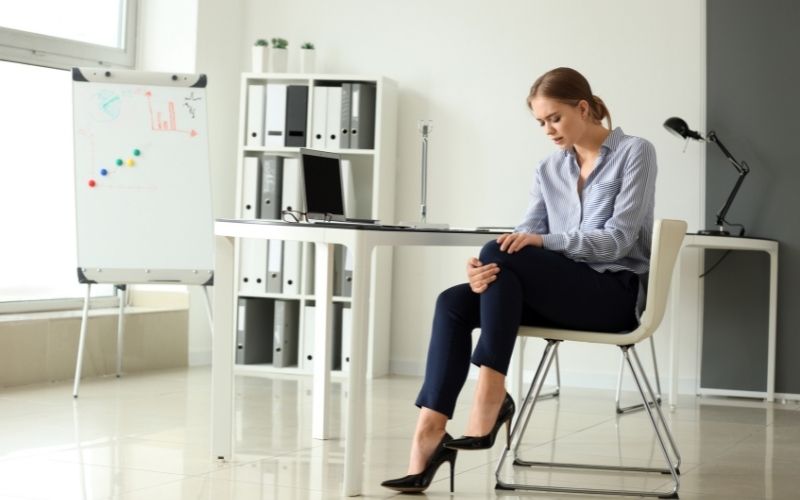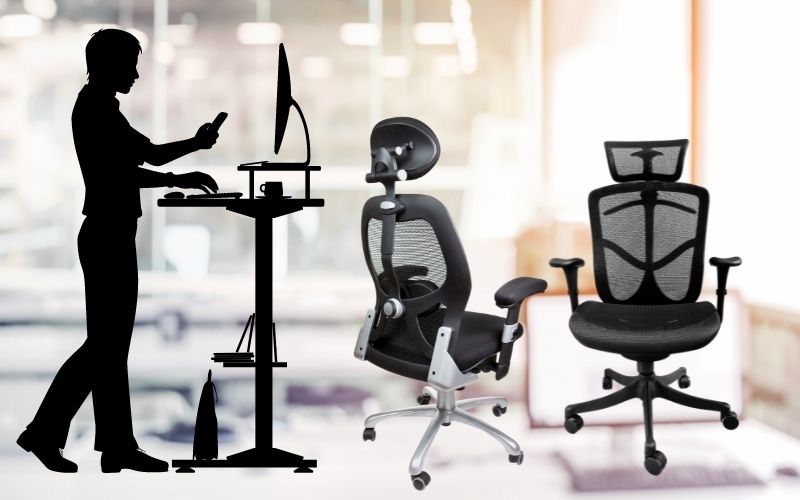For many years now, many organizations have come up with innovative solutions to remedy the harmful effects of prolonged sitting.
Some of them are the standing desk and the ergonomic chair, two entirely different products that dramatically change the way you work and offer similar benefits.
Between the two pieces of furniture, which offers a better level of ergonomics in the workplace?
Which should you prioritize?
In this article, we will be comparing the standing desk vs. an ergonomic chair. We will talk about their distinctive, as well as similar characteristics.
We will guide you through the pros and cons of each product and help you decide which one to buy if you are still deciding whether to invest in a standing desk or an ergonomic chair.
If you are interested in purchasing either, keep reading.
Table of Contents
What is a standing desk?
A standing desk is a tall desk designed for use while standing upright or sitting on a high stool.
We can classify standing desks into two types-fixed-height and height-adjustable . The latter, also known as sit-stand desks, are suitable for both sitting and standing positions and can be either manual or motorized.
Manual sit-stand desks equip cranks that you turn to adjust the height of the desk. Motorized or electric sit-stand desks, on the other hand, feature easy-to-use button controls.
What is an ergonomic chair?
Typically an office chair, an ergonomic chair is classified as such when it adapts to the user’s needs and provides comfort and customizable support. Ergonomic chairs are known to improve posture, reduce pain associated with prolonged sitting, and increase productivity levels.
Standing desk vs. Ergonomic chair: Side-by-Side Comparison
Apart from offering two completely different functionalities – one enables a comfortable standing position while the other provides a comfortable seating experience, standing desks and ergonomic chairs have several major differences.

Uses/Applications
Standing desks are more often used by architects, artists, chemists, and other professionals who typically work while standing up. Nowadays, standing desks are starting to become a trend in many workplaces, especially tech companies.
Ergonomic chairs, on the other hand, are more often used in offices. Employees whose jobs require them to sit while working all day are the most common users of ergonomic chairs.
Affordability
Depending on the brand, materials, and features, the price of both standing desks and ergonomic chairs can vary.

Standing desks, however, tend to be more expensive because they need more materials to build and their mechanisms are often more complicated.
Health and Other Benefits
Back Pain
Prolonged sitting has been known to cause back pain, especially when you do not use proper posture. Ergonomic chairs help ease back pain through their cushioned backrests and tilting or reclining mechanism.
-

With a standing desk, however, you are much less likely to slouch, and therefore less prone to backaches. While both ergonomic chairs and standing desks help reduce back pain, the latter is perhaps better for your back.
Based on a study conducted in 2011, a group of people who used sit-stand devices for four weeks reported a reduction in back pain by 50% and significant mood improvements.
Leg/Foot Pain
Sitting can cause leg and foot pain, whether from sitting too close to the front of the seat, crossing your legs, or tucking them under your thighs.

Ergonomic chairs remedy this problem by providing seat heights that can accommodate a variety of users.
Standing desks can cause leg or foot pain especially when users stand for long periods without taking breaks. This is due to the pressure standing puts on your knees, hips, and feet.
If you wear high-heeled shoes to work, leg and foot pain from standing can be even worse. Standing for long periods can also lead to blood collecting in your leg veins, resulting in varicose veins.
Productivity Levels
Back and other body pains caused by prolonged sitting is one of the most common causes of work absence. Employees who suffer from the negative health impacts of sitting often become less focused at work and also less productive.
Ergonomic chairs allow you to sit comfortably, and as a result, they help keep your energy levels stable. Standing desks, on the other hand, encourage more muscle activity than sitting, keeping your energy levels high and boosting your productivity.
Comparison Table: Summary
| Standing Desk |
Ergonomic Chair |
|
| Uses/Applications | Often used by architects, artists, and chemists | More commonly used in workplaces |
| Affordability | Usually more expensive | Generally less expensive |
Health and Other Benefits
|
|
|
Are standing desks more ergonomic?
Now that you know the main differences between standing desks and ergonomic chairs, you may be wondering, are standing desks more ergonomic?
Standing desks aren’t automatically ergonomic, at least not on their own.
For a standing desk to provide a good level of ergonomics, you will need to pair it with other tools or equipment that will make standing while working a more efficient position for you.
A standing desk chair, an anti-fatigue mat, and a footrest can help you maintain a comfortable posture while working at a standing desk.
Standing desk chairs and anti-fatigue mats help reduce the strain of standing, promote good posture, and encourage movement.
Is standing at your desk healthier than sitting?
For many years, prolonged sitting has been known to cause not only body pain and discomfort but also risks of developing serious health problems such as diabetes, heart disease, and obesity. The human body is not made for a sedentary lifestyle, and inactivity from too much sitting can have adverse effects in the long run.
Standing at your desk lowers the risks of weight gain. While it won’t help you burn as many calories as when you are exercising, burning a few calories while standing is still much better than none at all.
Standing also helps lower blood sugar levels. A study shows that participants who stood for about 180 minutes after lunch break saw a 43% reduction in blood sugar spikes compared to people who sat for the same amount of time.
Practicing standing at your desk instead of sitting all day can also be beneficial for your mental health. Muscle activity from standing while working can lead to increased vigor and energy, which can improve overall well-being.
Overall, standing is healthier than sitting. However, just as sitting for long hours can be bad for your health, prolonged standing can have negative effects on you.
A good combination of sitting and standing is the key to keeping a healthy and active lifestyle.
Conclusion
In summary, both standing desks and ergonomic chairs have numerous health benefits. Both pieces of furniture promise to improve overall health by encouraging comfortable positions while working.
Perhaps the main difference lies in whichever helps you overcome the effects of a sedentary lifestyle.
An ergonomic chair provides temporary relief from discomfort related to prolonged sitting while a standing desk prevents pain and discomfort by encouraging some muscle activity.
Remember, a good work setup is never going to make up for a lack of movement. So even if you have the perfect standing desk or the perfect ergonomic chair, don’t skip the gym or going out for a walk!

My name is Vance, and I am the owner of To Ergonomics. Our mission is to improve your workflow by helping you create a supportive and welcoming environment. We hope that you’ll find what you’re looking for while you’re here.






